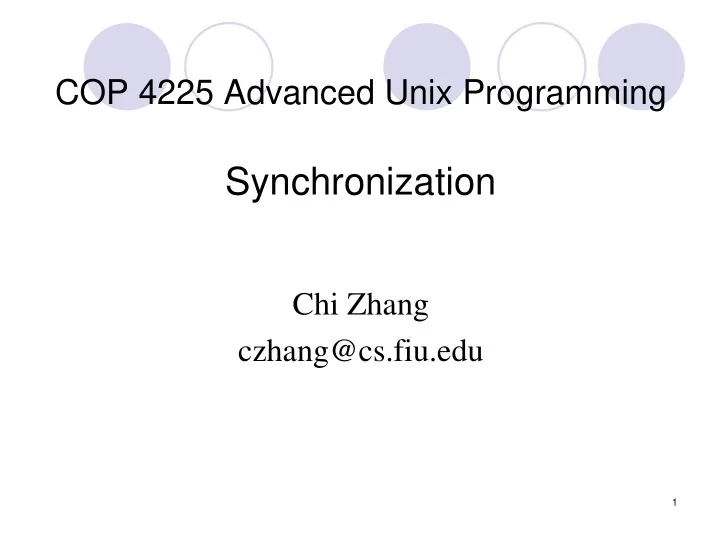

COP 4225 Advanced Unix Programming Synchronization Chi Zhang czhang@cs.fiu.edu 1
Cooperating Processes � Independent process cannot affect or be affected by the execution of another process. � Cooperating process can affect or be affected by the execution of another process � Advantages of process cooperation � Information sharing � Computation speed-up � Modularity � Convenience 2
Producer-Consumer Problem � Share the variables � Paradigm for cooperating processes, producer process produces information that is consumed by a consumer process. � bounded-buffer (circular array) assumes that there is a fixed buffer size. � A variable counter , initialized to 0 and incremented each time a new item is added to the buffer 3
Problem � Concurrent access to shared data may result in data inconsistency. � Maintaining data consistency requires mechanisms to ensure the orderly execution of cooperating processes. 4
Bounded-Buffer: Producer Process item nextProduced; while (1) { while (counter == BUFFER_SIZE) ; /* do nothing */ buffer[in] = nextProduced; in = (in + 1) % BUFFER_SIZE; counter++; } 5
Bounded-Buffer: Consumer Process item nextConsumed; while (1) { while (counter == 0) ; /* do nothing */ nextConsumed = buffer[out]; out = (out + 1) % BUFFER_SIZE; counter--; } 6
Bounded Buffer � The following statements must be performed atomically . counter++; register1 = counter register1 = register1 + 1 counter = register1 counter--; register2 = counter register2 = register2 – 1 counter = register2 7
Bounded Buffer � If both the producer and consumer attempt to update the buffer concurrently, the assembly language statements may get interleaved. � Interleaving depends upon how the producer and consumer processes are scheduled. 8
The Critical-Section Problem � Race condition : The situation where several processes access – and manipulate shared data concurrently. The final value of the shared data depends upon which process finishes last. � To prevent race conditions, concurrent processes must be synchronized . � Each process has a code segment, called critical section , in which the shared data is accessed. � Mutual Exclusion – ensure that when one process is executing in its critical section, no other process is allowed to execute in its critical section . 9
Semaphores � Semaphore S – integer variable � can only be accessed via two indivisible (atomic) operations. (S initialized to be the number of concurrent processes allowed. S==1 ⇒ Mutex) wait ( S ): while S ≤ 0 do no-op ; S --; signal ( S ): S++; 10
Critical Section of n Processes � Shared data: semaphore mutex; // initially mutex = 1 � Process Pi: do { wait(mutex); critical section signal(mutex); remainder section } while (1); 11
Semaphore Implementation: SpinLock � Busy waiting � Waste of CPU � Useful with Multiple Processors and short lock time � Context Switch is expensive � Disable interrupt and use atomic operations with SMP spin_lock: spin_unlock: 1: lock; decb slp Lock; movb $1, slp jns 3f 2: cmpb $0 , slp pause jle 2b jmp 1b 12 3: …
Semaphore Implementation � Define a semaphore as a record typedef struct { int value; struct process *L; // a queue of PCB } semaphore; � Assume two simple operations: � block suspends the process that invokes it. � wakeup( P ) resumes the execution of a blocked process P . 13
Implementation � Semaphore operations now defined as wait ( S ): S.value--; if (S.value < 0) { add this process to S.L; block; } signal ( S ): S.value++; if (S.value <= 0) { remove a process P from S.L; wakeup(P); } o S<0: its magnitude is the number of waiting processes 14
Bounded-Buffer Problem � Shared data � mutex:mutual exclusion for the critical section � full: the number of full buffers; for synchronization � empty: the number of empty buffers; for synchronization. semaphore full, empty, mutex; Initially: full = 0, empty = n, mutex = 1 15
Bounded-Buffer Problem Producer Process do { … produce an item in nextp … wait(empty); wait(mutex); … add nextp to buffer … signal(mutex); signal(full); } while (1); 16
Bounded-Buffer Problem Consumer Process do { wait(full) wait(mutex); … remove an item from buffer to nextc … signal(mutex); signal(empty); … consume the item in nextc … } while (1); 17
Critical Regions � High-level synchronization construct � A shared variable v of type T , is declared as: v: shared T � Variable v accessed only inside statement region v when B do S where B is a boolean expression. 18 � While statement S is being executed no
Solaris 2 Synchronization � Implements a variety of locks to support multitasking, multithreading (including real-time threads), and multiprocessing. � Uses adaptive mutexes for efficiency when protecting data from short code segments. � On a multiple processor system, an adaptive mutex starts as a spinlock. If the thread holding the lock is not currently running, the calling thread blocks and sleeps until the lock is released. � On a uniprocessor system, the thread always sleep rather than spin. � Uses condition variables and readers-writers locks when longer sections of code need access to data. � Multiple threads may read data concurrently. 19
Recommend
More recommend